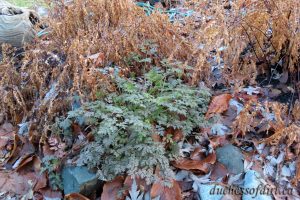Anthriscus sylvestris ‘Ravenswing’
|
Anthriscus sylvestris ‘Ravenswing’ Family: Apiaceae |
|
|
Description: An herbaceous, upright, delicate-looking perennial. Attractive, deeply incised, rosy-purple leaves make a frothy appearance in late winter or early spring atop thin purple stems. Airy cymes of white flowers add to the delicacy of this plant in late spring through mid-summer. Special Notes: Native across Europe, northwest Africa, western Russia and Asia Preference is for sunny to dappled shade locations; tolerant of poor soil conditions with moderate water. Drought tolerant once established. Cymes of white flowers attract pollinators and look good as cut flowers. Resistant to rabbits; not sure about deer. Slugs and snails may be a problem for young plants. Powdery mildew may be a problem in summer if in a crowded area with inadequate breeze. Self-seeds so best to deadhead spent flowers before seeds drops. However, young seedlings are easily pulled in the spring before their tap root has developed. Removing older plants means digging down to get all of the root. If you collect seed from this plant, it will need some vernalization (a cold period) in order to kick start germination. I find it much easier to let some seeds overwinter in place in the garden to sprout in the spring.
In our Zone 7a garden: This is one of my favourite plants for ease of care and bullet-tough constitution. Fresh foliage appears in late January, early February and handles surprise frosts well. An Australian nursery claims ‘Ravenswing’ is frost hardy to -10 °C (14 °F) and I believe it. There is never any frost damage on the early new growth after a late frost. All of our ‘Ravenswing’ have come from a single plant on which I occasionally left a few flowers to go to seed. I have not experienced any problems with slugs or snails or rabbits. We are fenced for deer but one got in recently but either did not find my newly emerging ‘Ravenswing’ plants or chose not to taste them.
Posted on February 8, 2024 |
|
Filipendula rubra ‘Venusta’
Francoa sonchifolia








